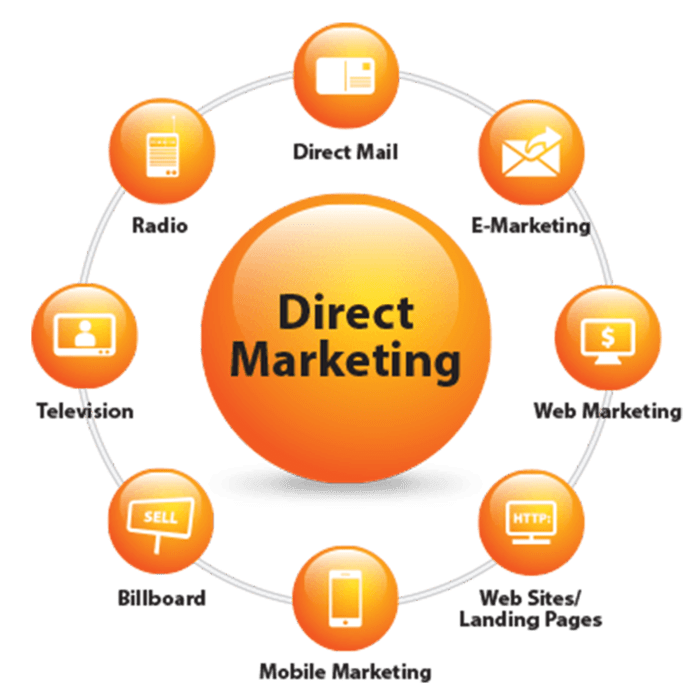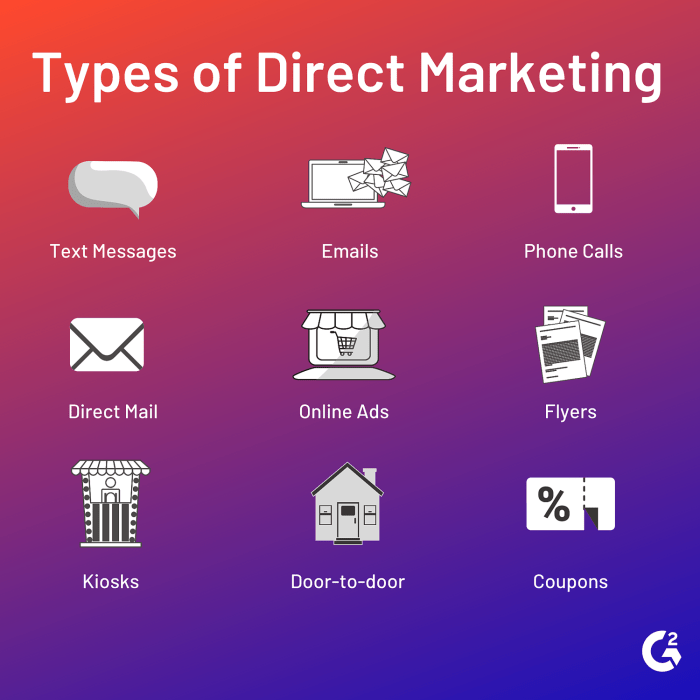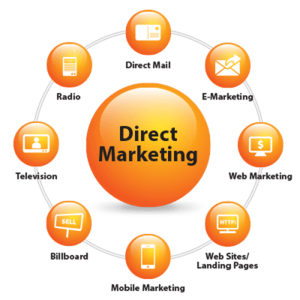
Define Direct Marketing
Direct marketing involves a direct and targeted approach to reach potential customers, aiming to establish a personal connection and foster long-term relationships.
Unlike traditional marketing, which focuses on mass communication, direct marketing allows businesses to tailor their messages and promotions to specific individuals or segments, based on their unique characteristics and preferences.
Key Characteristics
Direct marketing is characterized by several key attributes that differentiate it from traditional marketing approaches:
- Personalized Communication:Direct marketing emphasizes one-to-one interactions, enabling businesses to customize messages and offers based on individual customer data.
- Measurable Results:Direct marketing campaigns are designed to track and measure specific metrics, such as response rates, conversion rates, and return on investment (ROI), allowing businesses to assess the effectiveness of their efforts.
- Targeted Audience:Direct marketing campaigns are targeted at specific groups of customers based on demographics, behavior, or other relevant criteria, ensuring that messages are delivered to those most likely to be interested.
- Call-to-Action:Direct marketing campaigns typically include a clear call-to-action, encouraging customers to take a desired action, such as making a purchase or signing up for a newsletter.
Types of Direct Marketing
Direct marketing encompasses various channels to connect directly with target audiences. Each channel offers unique advantages and considerations:
Email Marketing
Email marketing involves sending personalized messages to a targeted list of subscribers. It allows for cost-effective and measurable campaigns, enabling businesses to nurture leads and drive conversions.
Advantages:
- Highly targeted
- Trackable and measurable
- Cost-effective
Disadvantages:
- Can be perceived as spam
- Limited attention span
Direct Mail Marketing
Direct mail involves sending physical mail pieces, such as postcards, brochures, and catalogs, to specific addresses. It offers a tangible and personal touch, targeting audiences based on demographics and geographic location.
Advantages:
- Tangible and attention-grabbing
- Can target specific demographics
- Provides a sense of exclusivity
Disadvantages:
- Expensive compared to digital channels
- Limited tracking capabilities
- Environmental concerns
Telemarketing
Telemarketing involves reaching out to potential customers over the phone. It allows for real-time interactions, building personal connections, and generating immediate sales.
Advantages:
- Personalized and interactive
- Immediate feedback and response
- Can qualify leads and close deals
Disadvantages:
- Can be intrusive and disruptive
- Requires skilled and experienced callers
- Legal regulations and compliance
Social Media Marketing
Social media marketing involves using social media platforms to connect with target audiences, build brand awareness, and drive traffic to websites. It allows businesses to engage with customers, monitor brand sentiment, and generate leads.
Advantages:
- Highly targeted and engaging
- Builds brand loyalty and community
- Provides real-time customer insights
Disadvantages:
- Can be time-consuming and resource-intensive
- Content can be easily overlooked or ignored
- Privacy and data protection concerns
Benefits of Direct Marketing
Direct marketing offers numerous advantages that contribute to the success of businesses. These benefits include targeted reach, personalized messaging, and measurable results.
Targeted Reach
Direct marketing enables businesses to precisely target their desired audience based on specific demographics, interests, and behaviors. This targeted approach ensures that marketing messages reach individuals who are genuinely interested in the products or services offered, leading to higher conversion rates.
For instance, a fitness center can utilize direct marketing to target individuals within a specific geographic area who have expressed an interest in health and fitness through online searches or social media interactions.
Personalized Messaging
Direct marketing allows businesses to tailor their messages to the specific needs and preferences of each individual. By leveraging customer data, businesses can create personalized messages that resonate with recipients, increasing engagement and driving conversions.
An example of personalized messaging in direct marketing is an email campaign that sends targeted offers to customers based on their previous purchases or browsing history.
Measurable Results
One of the significant advantages of direct marketing is its measurability. Businesses can track key metrics such as open rates, click-through rates, and conversion rates to gauge the effectiveness of their campaigns. This data-driven approach enables businesses to optimize their strategies for maximum impact.
For example, a direct mail campaign can be tracked using response codes or unique landing pages, providing valuable insights into the campaign’s performance and areas for improvement.
Challenges of Direct Marketing

Direct marketing, despite its effectiveness, is not without its challenges. Marketers must navigate data privacy concerns, intense competition, and fluctuating response rates to maximize campaign success.
Data Privacy Concerns, Direct Marketing
The collection and utilization of personal data in direct marketing raise concerns about data privacy. Consumers are increasingly vigilant about protecting their personal information, leading to stricter regulations and heightened consumer skepticism.
Competition
The direct marketing landscape is highly competitive, with numerous businesses vying for consumer attention. Marketers must differentiate their offerings and employ innovative strategies to stand out from the crowd.
Response Rates
Response rates in direct marketing can be unpredictable and vary depending on factors such as campaign design, target audience, and market conditions. Marketers must continuously monitor and optimize their campaigns to maximize response rates.
Best Practices for Direct Marketing
To achieve successful direct marketing campaigns, it’s essential to follow best practices that optimize results. These practices cover various aspects, including segmentation, personalization, content creation, and campaign measurement.
Segmentation is crucial for targeting specific audiences based on their demographics, interests, and behaviors. This allows for tailored messaging that resonates with each segment.
Personalization
Personalization involves customizing messages and offers to individual recipients. By using customer data, businesses can create personalized content that addresses specific needs and preferences, leading to higher engagement and conversions.
Content Creation
Effective direct marketing campaigns require high-quality content that captures attention and delivers value. Content should be relevant, informative, and persuasive, addressing the specific interests of the target audience.
Campaign Measurement
Tracking and measuring campaign performance is essential for evaluating effectiveness and making necessary adjustments. Metrics such as open rates, click-through rates, conversion rates, and return on investment (ROI) provide insights into campaign success and areas for improvement.
Future of Direct Marketing

Direct marketing is on the cusp of a transformative era, driven by technological advancements and evolving consumer behaviors. Emerging trends, such as artificial intelligence (AI), personalized experiences, and omnichannel marketing, are reshaping the landscape and creating unprecedented opportunities for businesses.
AI is revolutionizing direct marketing by automating tasks, improving targeting, and personalizing customer interactions. Machine learning algorithms analyze vast amounts of data to identify patterns and predict customer behavior. This enables marketers to deliver highly targeted and relevant messages to each individual.
Personalized Experiences
Customers today expect personalized experiences tailored to their specific needs and preferences. Direct marketing is embracing this trend by leveraging AI and data analytics to create personalized content, offers, and recommendations. By understanding customer demographics, purchase history, and online behavior, businesses can deliver highly relevant and engaging experiences that foster loyalty and drive conversions.
Omnichannel Marketing
In today’s digital age, consumers interact with brands across multiple channels, including email, social media, mobile apps, and websites. Omnichannel marketing integrates these channels to provide a seamless and consistent customer experience. By coordinating messaging and campaigns across all touchpoints, businesses can reinforce their brand message, improve customer engagement, and drive sales.





